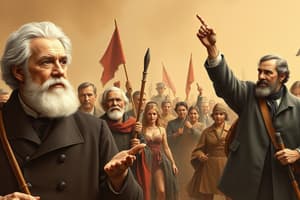Podcast
Questions and Answers
What does the term 'leadership' primarily refer to?
What does the term 'leadership' primarily refer to?
- The art of influencing people for cooperation and support. (correct)
- A position that requires no accountability.
- The ability to make all decisions for a group.
- The skill of managing people without influencing them.
Which virtue is associated with the habit of directing actions toward human life goals?
Which virtue is associated with the habit of directing actions toward human life goals?
- Temperance
- Prudence (correct)
- Justice
- Industry
What quality does the virtue of 'fortitude' help a leader develop?
What quality does the virtue of 'fortitude' help a leader develop?
- The ability to avoid all risks.
- Remaining indifferent in challenging situations.
- The habit of sharing resources with others.
- Overcoming difficulties in pursuit of goodness. (correct)
Which of the following virtues emphasizes accountability for actions?
Which of the following virtues emphasizes accountability for actions?
Which virtue focuses on the ability to control one's desires and inclinations?
Which virtue focuses on the ability to control one's desires and inclinations?
What is a key characteristic of a leader as defined in the content?
What is a key characteristic of a leader as defined in the content?
Which virtue is related to the habit of working hard under pressure?
Which virtue is related to the habit of working hard under pressure?
What does the virtue of 'cheerfulness' promote in a leader?
What does the virtue of 'cheerfulness' promote in a leader?
What is magnanimity primarily concerned with?
What is magnanimity primarily concerned with?
Which leadership style involves making decisions with no accountability for reasons given?
Which leadership style involves making decisions with no accountability for reasons given?
What is a key characteristic of teamwork as described in the text?
What is a key characteristic of teamwork as described in the text?
What does effective decision-making require according to the content?
What does effective decision-making require according to the content?
What is the primary focus of a youth organization?
What is the primary focus of a youth organization?
How is teamwork described in terms of effort and success?
How is teamwork described in terms of effort and success?
Which statement best describes the consultative leadership style?
Which statement best describes the consultative leadership style?
In decision-making, what does having options refer to?
In decision-making, what does having options refer to?
Which decision-making approach relies solely on a leader making decisions without input from others?
Which decision-making approach relies solely on a leader making decisions without input from others?
What does 'The Plop' refer to in decision-making processes?
What does 'The Plop' refer to in decision-making processes?
Which decision-making method is often effective in larger groups?
Which decision-making method is often effective in larger groups?
What is one potential downside of the Silent Consensus approach?
What is one potential downside of the Silent Consensus approach?
What is a characteristic of the Consensus decision-making method?
What is a characteristic of the Consensus decision-making method?
In which decision-making scenario do a few powerful personalities unintentionally dominate the group?
In which decision-making scenario do a few powerful personalities unintentionally dominate the group?
What is a potential consequence of 'The One-person Decision' approach?
What is a potential consequence of 'The One-person Decision' approach?
What does 'The Clique' entail in the context of decision-making?
What does 'The Clique' entail in the context of decision-making?
Flashcards are hidden until you start studying
Study Notes
Leader and Leadership
- Leadership involves influencing people to achieve community goals and maintain solidarity.
- Leaders are essential for decision-making, directing community activities, and representing the community.
- Effective leaders inspire followers to achieve results.
Virtues as the Foundation of Leadership
- Prudence: Making sound decisions by understanding the right course of action.
- Justice: Ensuring fairness and treating everyone with due respect, creating a secure environment.
- Fortitude: Overcoming challenges and persisting in the pursuit of goodness.
- Temperance: Controlling desires and impulses through reason.
- Industry: Working diligently and persevering under pressure.
- Loyalty: Staying committed to friends, principles, and goals during difficult times.
- Responsibility: Taking accountability for actions and obligations.
- Cheerfulness: Maintaining optimism and seeing opportunities.
- Generosity: Sharing resources and looking for ways to help others.
- Magnanimity: Having ambitious goals for good, aspiring to serve others and make a positive impact.
Leadership Styles
- Authoritarian: Leaders make decisions independently without explanation or input.
- Consultative: Leaders propose tentative decisions, open to feedback and discussion.
- Enabling: Leaders empower members to identify solutions and make decisions but retain veto power.
Building a Better Team
- Teamwork fosters camaraderie, unity, and shared effort.
- A strong team works together towards common goals, amplifying success.
Youth Organization
- Youth organizations are composed of teams with shared objectives.
- Effective team development is essential for achieving organizational goals.
Decision-making
- Decision-making is a complex process involving analysis, creativity, and communication.
- Decisions involve choosing between alternatives and committing to action.
- Decision-making is crucial for setting aspirations and turning goals into reality.
Decision-making Approaches
- Authoritarian: Leaders make decisions alone and impose them on the group.
- Democratic: Decision-making is shared between leaders and team members.
Different Decision-making Methods
- The Plop: Ideas are discarded without consideration.
- The One-person Decision: One person makes a decision without input.
- The Handclasp: A suggestion is accepted without discussion.
- The Clique: A select group makes decisions.
- The Minority: A few dominant personalities make decisions.
- The Majority Vote: Decisions are made by a majority vote.
- The Silent Consensus: Unanimous agreement is assumed even if some members disagree silently.
- The Consensus: Decisions are made through discussion, compromise, and agreement, fostering unity.
Studying That Suits You
Use AI to generate personalized quizzes and flashcards to suit your learning preferences.




